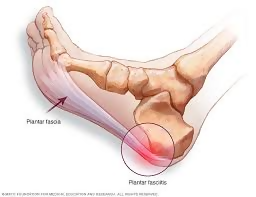 Heel pain is a common foot problem described as pain or discomfort experienced anywhere in the rear of the foot. It is estimated that every year around two million Americans suffer from heel pain, with athletes and seniors being the usual victims. While heel pain may be prevalent in the general population, it is not in any way normal. Neglect to any heel pain symptom can lead to bigger problems such as reduced mobility and capacity to enjoy life. Even the mildest form of heel pain can be an impediment to daily life, and if left untreated, it may progress and bring a chronic and debilitating pain. Certain risk factors increase your chance of developing heel pain, these include:
Heel pain is a common foot problem described as pain or discomfort experienced anywhere in the rear of the foot. It is estimated that every year around two million Americans suffer from heel pain, with athletes and seniors being the usual victims. While heel pain may be prevalent in the general population, it is not in any way normal. Neglect to any heel pain symptom can lead to bigger problems such as reduced mobility and capacity to enjoy life. Even the mildest form of heel pain can be an impediment to daily life, and if left untreated, it may progress and bring a chronic and debilitating pain. Certain risk factors increase your chance of developing heel pain, these include:
- Being overweight or obese
- Having flat or highly-arched feet
- Abnormal walking biomechanics and gait patterns
- Participating in high-impact activities
- Occupations that require a lot of standing or walking
- Wearing ill-fitting shoes or high heels frequently
In most cases, heel pain is not caused by a single injury. Repetitive stress on the heel and structural issues with the foot are the main culprit behind heel pain. There are many potential causes of heel pain, and the characteristic of pain varies depending on the underlying cause and its severity.
Plantar Fasciitis
Majority of heel pain cases is due to plantar fasciitis. The plantar fascia is a long thin ligament that stretches from your heel to your toes. Its main function is to provide support for the arch and dynamic shock absorption for the foot. Too much pressure on your feet damages the plantar fascia, and as a result, it becomes inflamed and causes pain. Many patients with plantar fasciitis often complain about a stabbing pain when they take their first steps in the morning. After a few minutes of walking, the pain gradually subsides and returns after long periods of using the feet.
Achilles Tendinitis
The Achilles tendon is a fibrous tissue that connects your calf muscles to your heel bone. Despite being the largest and toughest tendon in the body, the Achilles tendon is found to be very vulnerable to repetitive stress and overuse. When stretched beyond its normal range, the Achilles tendon develops inflammation and multiple microscopic tears. This results to a burning pain accompanied by swelling and stiffness in the calf and heel. Since Achilles tendinitis is an overuse injury, it is most commonly seen among athletes whose activities include a lot of running and jumping.
Heel Spurs
A heel spur is a bony-like outgrowth of the heel bone. Calcium deposits form an extra bone tissue as a response to long-term muscle and ligament strain. Most people with heel spurs do not feel pain, however, when pain is present, it is similar to plantar fasciitis.
Haglund’s Deformity
Haglund’s deformity occurs when a bony prominence forms at the back of the heel. Often called the pump bump, this condition commonly affects people who frequently wear high heels or any rigid footwear. The resulting pain is usually felt at the back of the heel and may cause limping. Haglund’s deformity, when left untreated, can further lead to painful bursitis.
Bursitis
Small fluid-filled sacs, called bursae, surround areas where tendons, skin, and muscle tissues meet bones. They provide cushioning and act as a gliding surface to reduce friction during movement of the joint. When they become swollen and inflamed, they cause pain and may limit motion.
Sever’s Disease
Sever’s disease happens because of the inflammation and repetitive microtrauma of the growth plate in the heels of growing children. Activities like running and jumping cause the already tight Achilles tendon to pull on and irritate the growth plate in the heel.
Heel pain affects a large number of people. And even though it is fairly common, heel pain requires close attention and immediate care. Heel pain treatment can begin at home with adequate resting, icing, stretching, and wearing more supportive and comfortable footwear. If it persists and stops you from doing your day-to-day activities, contact Ejodamen Shobowale, DPM of DeNiel Foot & Ankle Center, one of the best podiatrists in Houston, for more information. Whether you are looking for heel pain and plantar fasciitis treatment in Houston, or heel spur treatment in Houston, our foot doctor can give you the treatment you need to be pain-free and back on your feet.
Comments
[…] What Causes Heel Pain? […]
[…] Heel pain is a common complaint affecting people of all ages, often interfering with daily activities and overall quality of life. While medical conditions like plantar fasciitis and Achilles tendinitis are frequent culprits, lifestyle and footwear choices, including the type of sneakers worn, play a significant role in either exacerbating or alleviating heel pain. Sneakers designed specifically for heel pain can provide the necessary support and cushioning to mitigate discomfort and promote healing. Understanding the impact of these factors can help individuals make informed decisions to maintain healthy, pain-free feet.. […]
Comments are closed.